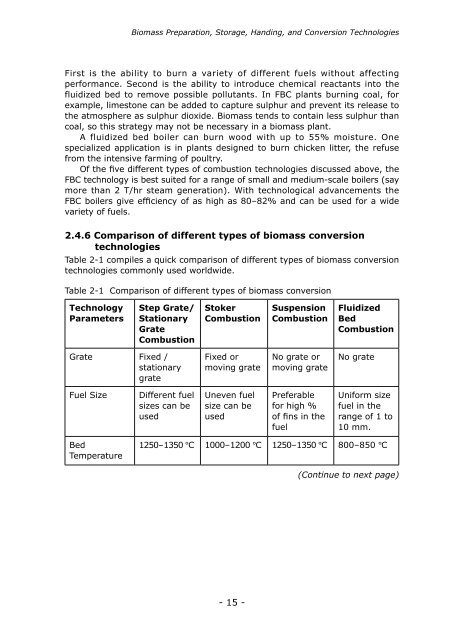Biomass as Fuel in Small Boilers (PDF 6.4 - APO Asian Productivity ...
Biomass as Fuel in Small Boilers (PDF 6.4 - APO Asian Productivity ...
Biomass as Fuel in Small Boilers (PDF 6.4 - APO Asian Productivity ...
Create successful ePaper yourself
Turn your PDF publications into a flip-book with our unique Google optimized e-Paper software.
<strong>Biom<strong>as</strong>s</strong> Preparation, Storage, Hand<strong>in</strong>g, and Conversion Technologies<br />
First is the ability to burn a variety of different fuels without affect<strong>in</strong>g<br />
performance. Second is the ability to <strong>in</strong>troduce chemical reactants <strong>in</strong>to the<br />
fluidized bed to remove possible pollutants. In FBC plants burn<strong>in</strong>g coal, for<br />
example, limestone can be added to capture sulphur and prevent its rele<strong>as</strong>e to<br />
the atmosphere <strong>as</strong> sulphur dioxide. <strong>Biom<strong>as</strong>s</strong> tends to conta<strong>in</strong> less sulphur than<br />
coal, so this strategy may not be necessary <strong>in</strong> a biom<strong>as</strong>s plant.<br />
A fluidized bed boiler can burn wood with up to 55% moisture. One<br />
specialized application is <strong>in</strong> plants designed to burn chicken litter, the refuse<br />
from the <strong>in</strong>tensive farm<strong>in</strong>g of poultry.<br />
Of the five different types of combustion technologies discussed above, the<br />
FBC technology is best suited for a range of small and medium-scale boilers (say<br />
more than 2 T/hr steam generation). With technological advancements the<br />
FBC boilers give efficiency of <strong>as</strong> high <strong>as</strong> 80–82% and can be used for a wide<br />
variety of fuels.<br />
2.4.6 Comparison of different types of biom<strong>as</strong>s conversion<br />
technologies<br />
Table 2-1 compiles a quick comparison of different types of biom<strong>as</strong>s conversion<br />
technologies commonly used worldwide.<br />
Table 2-1 Comparison of different types of biom<strong>as</strong>s conversion<br />
Technology<br />
Parameters<br />
Step Grate/<br />
Stationary<br />
Grate<br />
Combustion<br />
Grate Fixed /<br />
stationary<br />
grate<br />
<strong>Fuel</strong> Size Different fuel<br />
sizes can be<br />
used<br />
Bed<br />
Temperature<br />
Stoker<br />
Combustion<br />
Fixed or<br />
mov<strong>in</strong>g grate<br />
Uneven fuel<br />
size can be<br />
used<br />
- 15 -<br />
Suspension<br />
Combustion<br />
No grate or<br />
mov<strong>in</strong>g grate<br />
Preferable<br />
for high %<br />
of f<strong>in</strong>s <strong>in</strong> the<br />
fuel<br />
Fluidized<br />
Bed<br />
Combustion<br />
No grate<br />
Uniform size<br />
fuel <strong>in</strong> the<br />
range of 1 to<br />
10 mm.<br />
1250–1350 ºC 1000–1200 ºC 1250–1350 ºC 800–850 ºC<br />
(Cont<strong>in</strong>ue to next page)
















